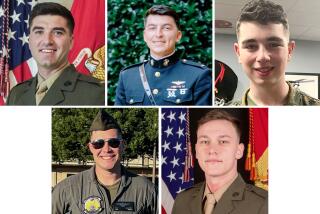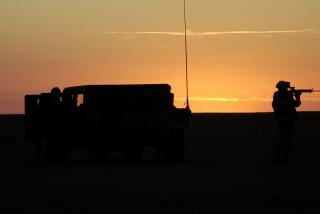Pendleton’s Masters of Deception Unveiled : War: Keeping Iraqi troops guessing, Marine’s 5th Brigade, returning home today, played quiet but vital role in Gulf victory.
- Share via
As they steamed in monotonous circles in the Persian Gulf, cramped and stir crazy below deck, the men of the Camp Pendleton-based 5th Marine Expeditionary Brigade had one gnawing thought that only worsened the boredom.
It was that soon--outgunned and despite terrible odds--they would hit the beach against entrenched Iraqi forces in a bloody amphibious landing on the heavily mined coast of occupied Kuwait.
Although that assault didn’t happen, the brigade still ended up playing a stunning but unheralded strategic role, details of which are now emerging publicly, that helped cast the quick outcome of the Gulf War.
The brigade, along with the 4th Marine Expeditionary Brigade from Camp Lejeune, N.C., bluffed Iraqi President Saddam Hussein into thinking there really would be a massive Marine amphibious assault. The deception tied up 80,000 to 100,000 Iraqi troops along the coast to defend against an attack that never came.
That tactic bottled up enemy troops, helping the allies wage a ground strike to the west and southwest that eventually swept around the bulk of Iraqi’s troops, bringing a dramatic victory and a cease-fire.
“Because we held them there, perhaps hundreds more soldiers, Marines and airmen came home,” said Lt. Col. Bill Myers, executive officer of the regimental landing team.
Lt. Gen. Walter Boomer, who commanded all Marine forces in the Persian Gulf theater, said of the brigade’s deception: “The job they did was tremendously important.”
Besides faking out the Iraqis, the brigade conducted a secret and unopposed landing 20 miles south of the Kuwait border. And, for the first time in warfare, the brigade used high-speed, air-cushioned landing craft to skim across the water to the shore.
Then, immediately upon landing, the brigade moved all day and night, covering 130 miles to collect enemy prisoners and engage in small fights with pockets of Iraqi soldiers.
Myers said it was “darn near a miracle” to race so fast and far inland right after an amphibious landing.
Now, after participating in the war and a humanitarian relief effort in cyclone-ravaged Bangladesh, about 3,500 Marines and sailors from the brigade, which has been nominated for a unit citation, return to San Diego today.
It is the last major Marine unit from the West Coast that fought in the war to come home. Part of the brigade has already returned to bases in Hawaii and the Philippines.
The brigade’s actions haven’t been widely disclosed, and the much larger 1st Marine Division from Camp Pendleton and the 2nd Marine Division from Camp Lejeune have gotten most of the attention.
“Their accomplishments in Desert Storm were largely overlooked because a high degree of security surrounded their landing,” Col. John Shotwell said.
But now, the small vanguard of the brigade’s officers and enlisted men who have already returned to Camp Pendleton are talking about their experiences as they await the return of their comrades.
The brigade shipped out for the Persian Gulf on Dec. 1, arriving in the war zone in mid-January for a probable attack on a painstakingly fortified enemy beach.
James Davis, a fresh-faced 26-year-old second lieutenant from Kansas, worried about how well he would lead his 35-man platoon in his first action. “I was anxious. But I had the attitude, ‘Don’t go in there believing you know everything.’ ”
He decided the wisest way to command was by listening to his men and seeking the advice of his experienced senior sergeants.
The uncertainty rubbed emotions raw, and Davis said there was incessant talk about casualties amid the tedium, friction and discomfort of life in the cramped quarters below deck during the brigade’s weeks of waiting off shore.
Cpl. Robert Bird, 22, of Des Moines, Iowa, said, “CNN didn’t help, either, saying there would be mass casualties.”
Davis tried to ease the tension, telling his men what little he knew.
Capt. Louis Herrera Jr. of San Antonio was grateful that the brigade eventually got to move onto land. “We got to at least go ashore. If they had stayed on ship (any longer), there probably would have been some serious morale and discipline problems.”
Because he was the assistant operation’s officer, Herrera heard briefings about three or four scenarios for an amphibious landing, all of them frightening.
The Marines were prepared to land a force on a coastline defended by six Iraqi divisions, which included up to 100,000 men bolstered by more artillery and tanks than the U.S. attack force had.
About 16,000 Marines and sailors, including 5,000 from the 5th Brigade, were aboard ship and under Navy command. When on land, they would be under direct Marine Corps command. The brigade is led by Brig. Gen. Peter Rowe.
“We were going to be outnumbered under any scenario,” Herrera said.
Meanwhile, Hussein and his generals were transfixed on the flotilla of sailors and Marines, wondering when and where the amphibious landing would take place and Marines would punch into Iraqi lines to cut through Kuwait.
The Iraqis had plenty of reason to expect an attack from the sea because on their way to the Gulf, the Marines quite visibly staged amphibious exercises that were calculated to be propaganda as much as military practice.
“They knew of our reputation, and that we could come from the sea, and obviously we would once it was known we were in the area,” Boomer said in an interview with The Times.
The 4th and 5th brigades, combined with their Navy ships, made up the largest amphibious task force carrying Marines since the Inchon landing in 1951 during the Korean War, according to Staff Sgt. Mike Stroup, a spokesman for the 5th Brigade.
Much to Boomer’s satisfaction, news media speculation about an amphibious assault only reinforced Iraq’s anticipation of a Marine landing that would require a commitment of Iraqi defensive forces.
But, as events unfolded, a different course was chosen by the allied top command.
Boomer said Iraqi’s huge main force required him to “risk” using both the 1st and 2nd divisions, “essentially leaving me with no reserves.” The 5th Brigade wouldn’t be used in an amphibious attack, but would instead try to deceive Hussein as long as possible, then come ashore at a safe place and march inland to reinforce the divisions.
Part of Boomer’s decision was shaped by a desire to avoid sending Marines into the meat grinder of a contested amphibious landing. “We were very much outnumbered by Iraqi forces,” he said.
Besides, the military estimates that there were 40,000 enemy mines along the Kuwaiti beaches, and a carpet of mines offshore to destroy ships.
Finally, on Feb. 24, ships carrying the brigade passed through mined waters, and more than 4,000 5th Brigade Marines came ashore at Ra’s al Mish’ab in Saudi Arabia. Troops landed by helicopter and the much-touted $28-million, 88-foot long air-cushioned landing craft. They can carry 76 tons of equipment, plus Marines, and reach a speed of 46 m.p.h.
Boomer said he had wanted to bring the Marines ashore earlier, but was reluctant to stop the charade that had kept so many Iraqi troops bound to the coast. “It was important to continue the deception,” he said.
The brigade speeded inland, securing supply routes and the Al Jabber airfield in Kuwait, then running into Iraqi resistance in the Al Wafra Forest area just south of Kuwait City, where two Marines were wounded. One of them, Cpl. Brett Doggett of Orange County, lost one foot and part of another when he stepped on a mine.
No other unit conducted both an amphibious landing and ground operations. One brigade veteran, Gunnery Sgt. Randy Blankenship, said: “It was a deception, and we also took ‘em head on. It was a double role nobody else did.”
Members of the brigade remember the smoke, the fear, the confusion and bravery of battle, although theirs was not the war’s big engagement with the enemy.
Capt. Herrera, as part of a 50-truck supply convoy, recalls his horror as he sent three Marines--not actual infantrymen, but cooks and the like--on the dangerous assignment of checking whether Iraqi soldiers were hiding in a trailer.
He had heard stories of allied troops getting killed or injured by friendly fire, so when he saw a Marine armored vehicle charging toward his three troops, he panicked.
“The guy has a machine gun right on them, I’m screaming, ‘Don’t shoot, don’t shoot. They’re ours, they’re ours!’ I just started running at them as fast as I could. I was almost in tears.”
It turned out that the armored vehicle, its machine gun at the ready, was racing toward the three Marines not to shoot at them but to give cover fire if needed.
Lt. Davis remembers distant firing and 10 overeager Marines charging pell-mell into the woods in search of Iraqis and an unhappy lieutenant having to plunge after them to round up his troops.
Perhaps the single most vivid memory was the smoke and darkness from the hundreds of oil wells the Iraqis sabotaged. “You could physically taste it,” Myers said. “I couldn’t even see my driver sitting next to me.”
Some Marines are a little disappointed that the diversion tactics, the unopposed landing and limited combat weren’t quite as legendary as the battle for Iwo Jima. But they seem satisfied with their footnote to military history.
“I hear we (were) used as a psychological thing to try and hold down some divisions, which worked,” Bird said. “It was important, I guess.”
But Herrera believes the camaraderie and the team effort was a heady experience. “It will carry these Marines through the rest of their lives,” he said.
More to Read
Sign up for Essential California
The most important California stories and recommendations in your inbox every morning.
You may occasionally receive promotional content from the Los Angeles Times.












